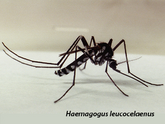Haemagogus
| Haemagogus | |
|---|---|
| Scientific classification | |
| Domain: | Eukaryota |
| Kingdom: | Animalia |
| Phylum: | Arthropoda |
| Class: | Insecta |
| Order: | Diptera |
| Family: | Culicidae |
| Subfamily: | Culicinae |
| Tribe: | Aedini |
| Genus: | Haemagogus Williston,1896[1] |
| Type species | |
| Haemagogus splendens | |
| Synonyms | |
|
CacomyiaCoquillett,1906 | |

Haemagogusis a genus ofmosquitoesin thedipteranfamilyCulicidae.They mainly occur inCentral Americaand northernSouth America(includingTrinidad), although some species inhabit forested areas ofBrazil,and range as far as northernArgentina.In theRio Grande Do Sularea of Brazil, one species,H. leucocelaenus,has been found carryingyellow fevervirus. Several species have a distinct metallic sheen.
Species of this genus arevectorsin the transmission of sylvan or "jungle" yellow fever, which is often carried bymonkeysin theforestcanopies.Haemagogusspecies have also been found to carry theMayaro virusandIlheusvirus.[2][3]As these mosquitoes, in general, have relatively long lives, they can transmit viruses for long periods.
They tend to live in the canopy of forests, where the female lays eggs in between layers of tree bark or in cutbamboo.The eggs adhere to the surface and when submerged by rain water develop intolarvae.
Species
[edit]- Haemagogus acutisentisArnell, 1973
- Haemagogus aeritinctusGalindo & Trapido, 1967
- Haemagogus albomaculatusTheobald, 1903
- Haemagogus anastasionisDyar, 1921
- Haemagogus andinusOsorno-Mesa, 1944
- Haemagogus argyromerisDyar & Ludlow, 1921
- Haemagogus baresiCerqueira, 1960
- Haemagogus boshelliOsorno-Mesa, 1944
- Haemagogus capricorniiLutz, 1904
- Haemagogus celesteDyar & Nunez Tovar, 1926
- Haemagogus chalcospilansDyar, 1921
- Haemagogus chrysochlorusArnell, 1973
- Haemagogus clarkiGalindo, Carpenter and Trapido, 1952
- Haemagogus equinusTheobald, 1903[4]
- Haemagogus iridicolorDyar, 1921
- Haemagogus janthinomysDyar, 1921
- Haemagogus leucocelaenusDyar & Shannon, 1924
- Haemagogus leucophoebusGalindo, Carpenter and Trapido, 1952
- Haemagogus leucotaeniatusKomp, 1938
- Haemagogus luciferHoward, Dyar & Knab, 1912
- Haemagogus mesodentatusKomp & Kumm, 1938
- Haemagogus nebulosusArnell, 1973
- Haemagogus panarchysDyar, 1921
- Haemagogus regalisDyar & Knab, 1906
- Haemagogus soperiLevi-Castillo, 1955
- Haemagogus spegazziniiBrethes, 1912
- Haemagogus splendensWilliston,1896[1]
- Haemagogus tropicalisCerqueira & Antunes, 1938
Yellow fever epidemics involvingHaemagogusspecies
[edit]The discovery in 1953 by two scientists from theTrinidad Regional Virus Laboratoryof a sickRed Howlermonkey that was found to be suffering fromyellow feverprovided the first indication that yellow fever was stillendemicin Trinidad although there had not been a case reliably reported from Trinidad since an outbreak in 1914. Blood specimens taken from over 4,500 humans in late 1953 and early 1954 and checked to detect the presence of a wide variety of known viruses showed that 15% had antibodies to the yellow fever virus. A form of the disease, termed "jungle yellow fever", was shown to be carried by Red Howler monkeys (Alouatta seniculus insulanusElliot) that provided a continuous reservoir for the disease, which was then spread by theHaemagogus s. spegazzinimosquito which normally inhabits rainforest regions, both at ground level and in the treetops.
After government felling of large stands of native forest,yellow feverwas isolated from a patient from Cumaca in the northern range in 1954. The infection soon spread to otherhumansand into theAedes aegyptimosquito population, greatly increasing transmission. Warnings were made that an epidemic was imminent and Dr.Wilbur Downsand Dr. A. E. (Ted) Hill, a specialist intropical medicine,began a program of inoculating health workers and stockpiling vaccine. Trinidad health authorities followed up with large-scale vaccination and intensive anti-aegyptimeasures including public education, regular inspection for breeding sites, and spraying of domestic residences withDDT.In spite of these measures, and the fact that an estimated 80% of the population ofPort of Spainwere immune to yellow fever and dengue, several more cases were soon reported. Most probably due to the health measures taken, it did not develop into a widespread epidemic in Trinidad itself.
An attempt was made to totally quarantine the island just before Christmas, 1954, but the disease spread to the nearby mainland ofVenezuelaand, from there, all the way to southern Mexico, probably killing several thousand people in the process.[6]
In 1998 an epidemic of yellow fever killed many Howler monkeys near the city ofAltamira, Paráin the easternAmazon basin,in Brazil. The virus was isolated in specimens ofHaemagogus janthinomysmosquitoes.[7]
Footnotes
[edit]- ^abcWilliston, Samuel Wendell (1896)."On the Diptera of St. Vincent (West Indies)".Transactions of the Entomological Society of London.1896:253–446, pls. 8–14.Retrieved3 June2018.
- ^The Arthropod-borne Viruses of Vertebrates: An Account of The Rockefeller Foundation Virus program 1951-1970.1973, pp. 133, 153. Max Theiler and W. G. Downs. Yale University.ISBN0-300-01508-9.
- ^"Haemagogus mosquito may be a vector for Diseases Database".
- ^Haemagogus equinusTheobald, 1903. Integrated Taxonomic Information System,https://www.itis.gov/servlet/SingleRpt/SingleRpt?search_topic=TSN&search_value=126524#null.
- ^"Haemagogus - Encyclopedia of Life".
- ^The Arthropod-borne Viruses of Vertebrates: An Account of The Rockefeller Foundation Virus program 1951-1970.1973, pp. 155-157. Max Theiler and W. G. Downs. Yale University.ISBN0-300-01508-9.
- ^Mondet, B; Vasconcelos, P.F.C; Travassos Da Rosa, A.P.A; Travassos Da Rosa, E.S; Rodrigues, S.G; Travassos Da Rosa, J.F.S; Bicout, D.J (2002). "Isolation of Yellow Fever Virus from NulliparousHaemagogus(Haemagogus)janthinomysin Eastern Amazonia ".Vector-Borne and Zoonotic Diseases.2(1): 47–50.doi:10.1089/153036602760260779.PMID12656130.
References
[edit]- The Arthropod-borne Viruses of Vertebrates: An Account of The Rockefeller Foundation Virus program 1951-1970.1973. Max Theiler and W. G. Downs. Yale University.ISBN0-300-01508-9.
- Global Mapping of Infectious Diseases: Methods, Examples and Emerging Applications.(1963). Edited by S. I. Hay, Alastair Graham, David J. Rogers. Updated edition with DVD 2007. Academic Press; Pbk/Dvdr R edition.ISBN978-0-12-031764-6.
External links
[edit]- Haemagogusat Encyclopedia of Life
- Vasconcelos, Pedro F.C; Sperb, Alethéa F; Monteiro, Hamilton A.O; Torres, Maria A.N; Sousa, Maria R.S; Vasconcelos, Helena B; Mardini, Lúcia B.L.F; Rodrigues, Sueli G (2003). "Isolations of yellow fever virus from Haemagogus leucocelaenus in Rio Grande do Sul State, Brazil".Transactions of the Royal Society of Tropical Medicine and Hygiene.97(1): 60–2.doi:10.1016/S0035-9203(03)90023-X.PMID12892055.
- World Health Report on Yellow Fever
